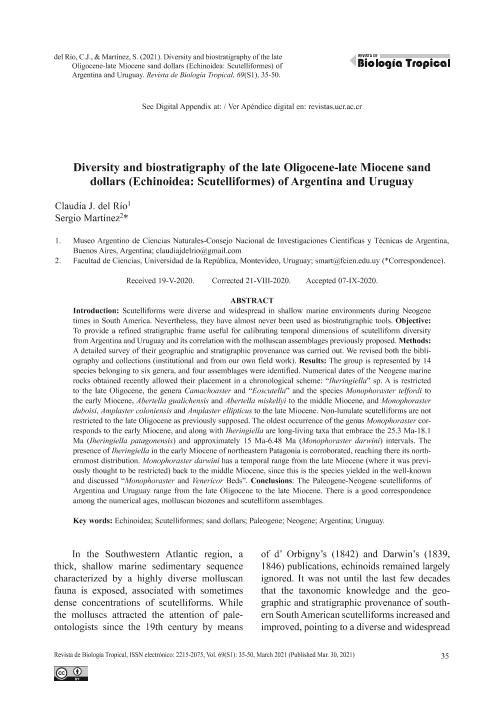Mostrar el registro sencillo del ítem
dc.contributor.author
del Río, Claudia Julia

dc.contributor.author
Martinez, Sergio
dc.date.available
2022-02-16T11:35:13Z
dc.date.issued
2021-03
dc.identifier.citation
del Río, Claudia Julia; Martinez, Sergio; Diversity and biostratigraphy of the late oligocene-late miocene sand dollars (Echinoidea: Scutelliformes) of Argentina and Uuguay; Revista de Biología Tropical; Revista de Biología Tropical; 69; supp1; 3-2021; 35-50
dc.identifier.issn
0034-7744
dc.identifier.uri
http://hdl.handle.net/11336/152093
dc.description.abstract
Introduction: Scutelliforms were diverse and widespread in shallow marine environments during Neogene times in South America. Nevertheless, they have almost never been used as biostratigraphic tools. Objective: To provide a refined stratigraphic frame useful for calibrating temporal dimensions of scutelliform diversity from Argentina and Uruguay and its correlation with the molluscan assemblages previously proposed. Methods: A detailed survey of their geographic and stratigraphic provenance was carried out. We revised both the bibliography and collections (institutional and from our own field work). Results: The group is represented by 14 species belonging to six genera, and four assemblages were identified. Numerical dates of the Neogene marine rocks obtained recently allowed their placement in a chronological scheme: “Iheringiella” sp. A is restricted to the late Oligocene, the genera Camachoaster and “Eoscutella” and the species Monophoraster telfordi to the early Miocene, Abertella gualichensis and Abertella miskellyi to the middle Miocene, and Monophoraster duboisi, Amplaster coloniensis and Amplaster ellipticus to the late Miocene. Non-lunulate scutelliforms are not restricted to the late Oligocene as previously supposed. The oldest occurrence of the genus Monophoraster cor-responds to the early Miocene, and along with Iheringiella are long-living taxa that embrace the 25.3 Ma-18.1 Ma (Iheringiella patagonensis) and approximately 15 Ma-6.48 Ma (Monophoraster darwini) intervals. The presence of Iheringiella in the early Miocene of northeastern Patagonia is corroborated, reaching there its north-ernmost distribution. Monophoraster darwini has a temporal range from the late Miocene (where it was previously thought to be restricted) back to the middle Miocene, since this is the species yielded in the well-known and discussed “Monophoraster and Venericor Beds”. Conclusions: The Paleogene-Neogene scutelliforms of Argentina and Uruguay range from the late Oligocene to the late Miocene. There is a good correspondence among the numerical ages, molluscan biozones and scutelliform assemblages.
dc.format
application/pdf
dc.language.iso
eng
dc.publisher
Revista de Biología Tropical

dc.rights
info:eu-repo/semantics/openAccess
dc.rights.uri
https://creativecommons.org/licenses/by/2.5/ar/
dc.subject
ARGENTINA
dc.subject
ECHINOIDEA
dc.subject
NEOGENE
dc.subject
PALEOGENE
dc.subject
SAND DOLLARS
dc.subject
SCUTELLIFORMES
dc.subject
URUGUAY
dc.subject.classification
Paleontología

dc.subject.classification
Ciencias de la Tierra y relacionadas con el Medio Ambiente

dc.subject.classification
CIENCIAS NATURALES Y EXACTAS

dc.title
Diversity and biostratigraphy of the late oligocene-late miocene sand dollars (Echinoidea: Scutelliformes) of Argentina and Uuguay
dc.title
Diversidad y bioestratigrafía de las galletas de mar (Echinoidea: scutelloida: scutellifomes) del oligoceno tardío-mioceno tardío de Argentina y Uruguay
dc.type
info:eu-repo/semantics/article
dc.type
info:ar-repo/semantics/artículo
dc.type
info:eu-repo/semantics/publishedVersion
dc.date.updated
2021-12-03T21:36:37Z
dc.journal.volume
69
dc.journal.number
supp1
dc.journal.pagination
35-50
dc.journal.pais
Costa Rica

dc.journal.ciudad
Turrialba
dc.description.fil
Fil: del Río, Claudia Julia. Consejo Nacional de Investigaciones Científicas y Técnicas. Oficina de Coordinación Administrativa Parque Centenario. Museo Argentino de Ciencias Naturales "Bernardino Rivadavia"; Argentina
dc.description.fil
Fil: Martinez, Sergio. Universidad de la República. Facultad de Ciencias; Uruguay
dc.journal.title
Revista de Biología Tropical

dc.relation.alternativeid
info:eu-repo/semantics/altIdentifier/doi/http://dx.doi.org/10.15517/RBT.V69ISUPPL.1.46324
dc.relation.alternativeid
info:eu-repo/semantics/altIdentifier/url/https://revistas.ucr.ac.cr/index.php/rbt/article/view/46324
Archivos asociados
